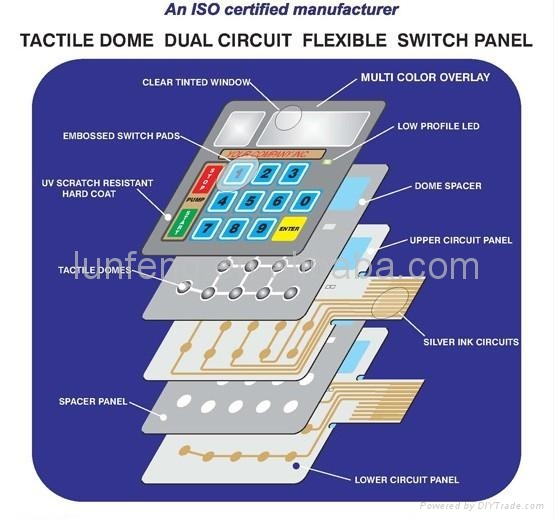Recognizing Membrane Switches Over: The Key to Sturdy and Trustworthy Controls

What Are Membrane Switches?
Membrane layer buttons are an innovative solution in the realm of user interface innovation, integrating capability and design seamlessly. These gadgets function as an interface between individuals and electronic systems, integrating a number of parts right into a portable layout. Typically constructed from flexible, thin layers of materials, membrane switches are developed to react to touch, allowing customers to interact with machinery and digital tools properly.
The key components of a membrane layer button include a printed circuit layer, graphic overlay, and a spacer layer that prevents unintended activation. The visuals overlay can be tailored to mirror brand name identity or user preferences, enhancing looks while making sure functionality. Membrane switches are generally made use of in different applications, including medical tools, customer electronics, and commercial equipment, owing to their longevity and resistance to ecological variables such as wetness and dust.
Among the vital advantages of membrane buttons is their capability to withstand damage, making them suitable for high-traffic atmospheres. Additionally, they are light-weight and need minimal room, enabling innovative layouts in product growth. Generally, membrane switches over represent a sensible and effective choice for contemporary electronic interfaces, weding innovation with user-centric design principles.
Just How Membrane Switches Over Work
The procedure of membrane changes depend upon an easy yet reliable mechanism that converts user input into digital signals. These switches include multiple layers, usually consisting of a graphic overlay, a spacer layer, and a circuit layer. When an individual presses the button, the top layer flaws, allowing a conductive component in the circuit layer to reach a matching conductive pad on the bottom of the graphic overlay. This call closes the circuit and sends out an electronic signal to the gadget, indicating that the button has been activated.
The style of membrane layer buttons can differ, but they typically include domes or responsive elements to supply responses to the customer, boosting the overall experience - membrane switch. The materials used in membrane layer switches, such as polyester or polycarbonate, contribute to their resilience and resistance to environmental variables, consisting of dampness and dirt. Furthermore, the printed circuits are generally encapsulated, which safeguards them from deterioration in time.
Benefits of Membrane Buttons

In addition, membrane layer buttons are recognized for their resilience. Constructed from robust important link materials, they are resistant to dust, wetness, and physical wear, which dramatically expands their life-span contrasted to typical mechanical buttons. This durability makes them particularly suitable for high-traffic environments and applications requiring longevity.
Another significant benefit is the ease of cleaning and upkeep. The smooth surface area of membrane layer switches over lessens dirt build-up and is commonly unsusceptible spills, making them suitable for setups that need frequent sanitization.
Moreover, membrane layer buttons use a streamlined profile, leading to a thinner layout that can be incorporated into various tools without including bulk. This feature not only boosts the visual charm however also adds to an extra ergonomic item style.
Applications of Membrane Switches
Easy to use and flexible, membrane layer buttons find applications across a large range of markets, including clinical tools, consumer electronics, and commercial devices. In the clinical field, these switches are indispensable to gadgets such as analysis devices, patient surveillance systems, and infusion pumps, where reliability and convenience of cleaning are critical. Their capacity to keep and endure harsh atmospheres functionality makes them excellent for such applications.

In customer electronics, membrane layer buttons are used in items like microwaves, cleaning equipments, and push-button controls - membrane switch. Their streamlined design permits for intuitive user interfaces, improving the total user experience while offering durability and resistance to use and tear
Commercial equipment likewise takes advantage of membrane layer buttons, particularly in control panels for machinery and automation systems. These switches provide defense versus dirt and moisture, guaranteeing constant efficiency in tough settings. Additionally, their adjustable functions enable suppliers to customize them to specific operational needs, enhancing efficiency and performance.
Choosing the Right Membrane Switch Over
When picking a membrane layer button, it is necessary to take into consideration numerous aspects that influence performance and suitability for details applications. The key factors to consider include environmental conditions, tactile responses, durability, and layout requirements.
First, analyze the operating atmosphere; switches exposed to dampness, chemicals, or severe temperatures require specific products to useful site make certain durability and performance. Next, evaluate the demand for tactile feedback. Relying on individual interaction, some applications might benefit from a tactile action to verify activation, while others might like a non-tactile design for visual factors.
Sturdiness is another essential aspect; membrane buttons ought to be made to stand up to frequent usage, effects, and abrasion. Ensure the chosen switch can sustain the expected lifecycle, particularly in high-usage circumstances.

Conclusion
To conclude, membrane switches over serve as vital components in the layout of long lasting and dependable control systems across various markets. Their compact layout, combined with durable building and personalized functions, enhances individual communication while making sure longevity in requiring environments. The adaptability of membrane switches over enables customized solutions that fulfill certain operational requirements, enhancing their importance in modern-day technology. As markets remain to develop, the importance of integrating reliable membrane switch services can not be overemphasized.
Membrane changes stand for a critical aspect of contemporary user interface layout, mixing capability with resilience in various applications.Membrane layer buttons are a sophisticated solution in the realm of user interface innovation, combining functionality and style flawlessly. Typically constructed from flexible, thin layers of products, membrane layer buttons are made to react to touch, making it possible for individuals to engage with equipment and electronic gadgets efficiently.
The design of membrane buttons can differ, yet they commonly include domes or responsive aspects to offer comments to the individual, improving the general experience.In final thought, membrane switches over offer as crucial components in the design of resilient and trusted control systems throughout different markets.
Comments on “The Role of Membrane Switches in Enhancing Device Functionality”